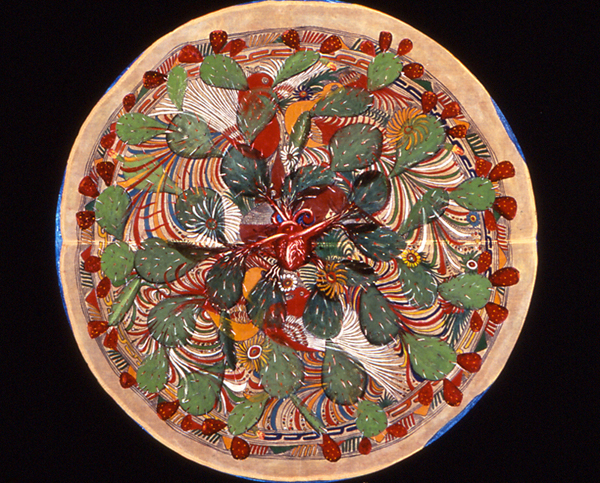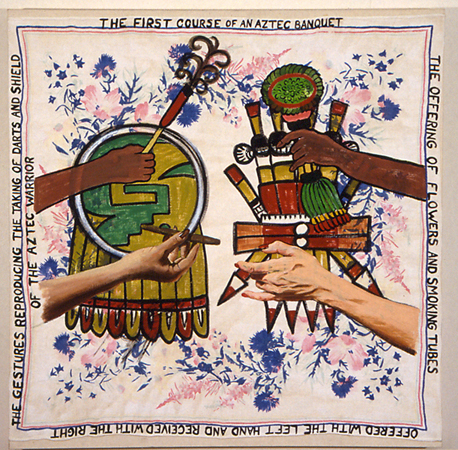Moctezuma’s Table
Jul 12–Sep 1, 2008
Image Gallery



Moctezuma’s Table
Jul 12–Sep 1, 2008
July 12 – September 1, 2008
Semmes Library
Featuring Rolando Briseño
Written by Amalia Mesa Bains
For over eighteen years Rolando Briseño has been pursuing themes related to the table and food as representations of a life source. The works transform the materials of everyday life by integrating the metaphor of food as a cultural and political phenomenon. Using historical references of Pre-Hispanic cuisine, the works reflect on-going questions of economic and social power relations that Briseño has pursued for many years. Through humor, irony and the context of popular culture, the artist has established a vocabulary that links content and form. In this sense the mixed media series, Moctezuma’s Table must be understood within both the ancient and contemporary context.
In order to set the ancient context it is important to recognize that the legendary cuisine of Mexico dates back as far as 300 A.D. in some of the archival cultural materials of the Maya civilization. Although the Spanish introduced their favorite recipes in 1520, the Aztec foods were already lavish feasts chronicled by writers of the time. The journals of Bernal Diaz del Castillo, a soldier, described the miraculous Mexico City of 1520,
“When I beheld the scene around me, I thought that this was the garden of the world. Moctezuma’s cooks had upwards of thirty different ways of dressing meats and had earthenware vessels so contrived as to keep them always hot. For the table of Moctezuma, himself, above three thousand dishes were dressed; and for his guards, above a thousand.”
This tabled Aztec cuisine included the staples of Mesoamerica now shared with the world such as tomatoes, beans, vanilla, chilies, maize, avocados, eggplants, potatoes, cashews, peanuts, and chocolate. Integral to the basic diet of the indigenous and mestizo people of Mexico has been maize or corn as we know it. Maize, which grows in about a dozen rich colors, has played a role in the history of Mexico. It was believed that this vegetable was invented by the great god Quetzalcoatl, who brought civilization from the Huaxteca region. Legend has it that Quetzalcoatl turned himself into a black ant and accompanied a red to being corn, the food of the gods, to the people.
Quetzalcoatl carried the corn to Tamoanchan, a mythical Mayan place of creation, where the gods chewed up the corn and put it into the mouths of humans. The symbolic place of corn can even be found in creation myths of Popol-Vuh, the sacred writings of the Maya. All the creations of man from clay, wood and reeds failed and only the white and yellow corncobs pleased the Creator and according to the sacred book”
They made their flesh of the yellow and white ears of corn..then, they husked and ground the yellow and white ears, and Ixmucane made nine drinks, these elements belonging to substances destinated to give life, force and energy to the people. The tzite corn was the flesh of man..this is how our forefathers and our fathers were created and formed.”
The multitude of dishes that arise from corn include at least two hundred varieties of the tamal as well as life sustaining drinks like atole, corn gruel. This basic food was at the heart of pattern of culture that wood continue for three thousand years. In combination with beans, squash and chilies, corn completed what we now know as complex carbohydrates that create the amino acid chain which produces protein. The elevated cuisine of nobles and court was in lessor forms the foundational life source of the workers. Implicit in the history of Mexico’s cuisine is the explorations of Spaniards searching for the marvelous Spice Islands of the East described by Marco Polo. There is irony in the realization that the Mesoamerican world was forever changed by misdirected merchants searching for pepper. We can not fail to recognize the more lasting benefit to Europe rather than the discovery of gold was the wonder of the tomato, the potato and chocolate.
The blending of Spanish traditions and Pre-Hispanic cuisine has transformed the history of food around the world. One of the dishes most emblematic of the mezcla of indigenous and Spanish cuisine is mole the famous rich sauce invented in the kitchens of the convents. According to food historian, Marilyn Tausend, Oaxaca is the land of the seven moles, which is a reflection of the rich history of Mexican cooking. The word mole comes from the Nahuatl word meaning concoction. Moles are rich complex mixtures of chilies, tomatoes, squash seeds, nuts, spices, meats and sesame seeds. The black mole negro uses chocolate as does the lighter coloradito or red mole. Greens, herbs, chilies and tomate verde form the basis of green mole. These mixture are representational of the mestizaje of cultural mixture of European, Indian and African heritage central to the identity of Mexico.
Despite the North American perception of Mexican fast food as a narrow collection of tacos and burritos, the cuisine of Mexico contains over four thousand dishes surpassed only by French and Chinese cuisine. It is within this context of rich and complex histories that Briseño situates his series own research includes studies of Pre-Columbian and Mexican cooking listed in the bibliographic materials accompanying this exhibition. Briseño takes up the metaphor of food as the ceremonial body as well as food as colonial mestizaje.
If we see Rolando Briseño’s work as a metaphor of culture and history than we must also see food as the metaphor of life. Food as consumption; food as nature; or food as sexuality and hybridity. From birth until death we are dominated by its life-giving necessity and as a nation we have a struggled with our problematic approach-avoidance as a country of obese dieters. Mexico’s cuisine has been a record of its racial mixtures, revolutions, wars, invasions, religion, landscape and the power relations of classes between Indians, Mestizos and the Spanish. The annexation of over half of Mexico’s empire following the 1836 loss of Texas and the continued loss following the 1848 Mexican-American war with the United States transferred the agricultural abundance to the North American side of the border. In this historic events Mexican were encapsulated as internal colonials and began there history as agricultural workers simultaneously forever integrating their cuisine within the culture of the United States
Here in the United States in a time of Mexican fast food acceleration and racist advertising that characterizes Mexican culture and food through a Chihuahua, we ponder the political context of these media campaigns. There is an unavoidable and bittersweet irony as legislation attempts to scapegoat the Mexican as a drain on the US economy and education, billingualism, affirmative action and public health services come under attack while America pursues the bountiful burrito. As Mexican laborers plant and harvest, prepare and serve the food of the American southwest while living in substandard conditions we can not fail to see the acute history we have played in the agricultural life of this country from field to table. It within both this ancient mythic past and this extreme contemporary contradiction that we approach Moctezuma’s Table.
In these new works we find an integration of the table trough the mixed media use of napkins, table cloths and containers while the ingredients of masa, chocolate and chilies become the culinary palette of the artist. The quotidian is at play as the table becomes our record of daily life at the hands of the artist. Briseño uses humor and integrates the lore of the Nahuatl world in the metaphor of the body in Tomatl. Ixtomatl or plump thing with a navel refers to the fattening of the human body in this acrylic and oil piece on napkin. The Corazón de Chocolate brings the sensuality and richness to the religious symbol of the ancient world as the cacao pod was then known as the metaphor of the human heart. As such chocolate was highly esteemed. Briseño’s contemporary sacrifice is cast chocolate presented with Hershey sauce in a Godiva box. Like the Mesoamerican act of transubstantiation through sacrifice we gain our own tonalli or energy from this seductive work of art. We are reminded of the Castas paintings of Mexico which recorded in the colonial age the potent racial mixture of humans in Briseño’s Mole Wheel. Like the caste paintings that also depicted the hybridities of fruits and vegetables the mole wheel affords us the taxonomy of color and taste in this artistic and culinary mestizaje.
The artist pursues the commodification of Mexican/Chicano culture and cuisine in both Pre-Columbian Corporate Logo and Tortilla Tower in a culinary rasquachismo where humor and appropriation attest to the cultural homogenization at the hands of corporate America. And the ever present Esquincle, vestige of the sacred guide to the afterlife is a sad reminder of the Taco Bell Chihuahua that haunts our everyday life with racist images of our own identity. Briseño’s work are a timely and inventive commentary on the power relations of culture within the United States and between the US and Mexico in an age of ever increasing media control.
Moctezuma’s Table is a piquant series that freely mixes everyday objects and culinary references in a rehistorization of culture for the Mexican and the Chicano. Metaphor and satire are the strategies employed in this exploration as Briseño once again calls us to regard our foods of life that have sustained us in difficult times and remain the stuff of our existence.